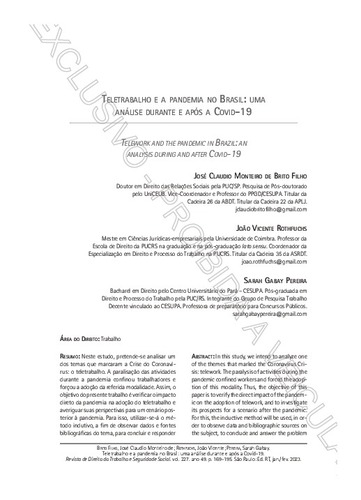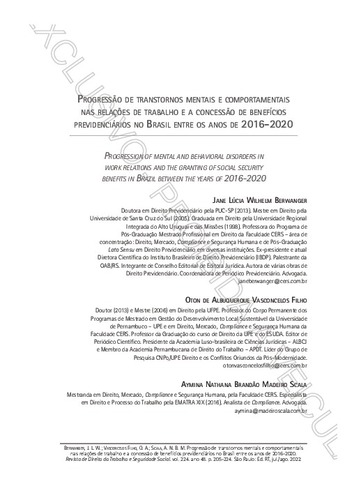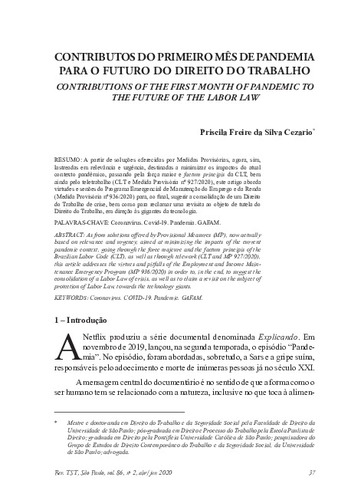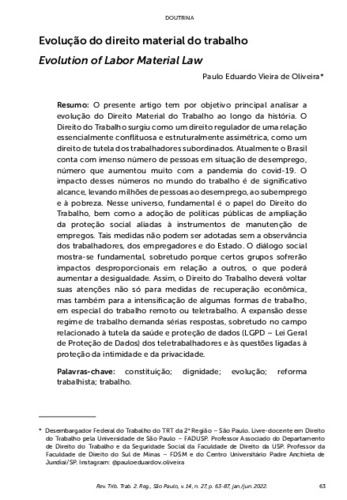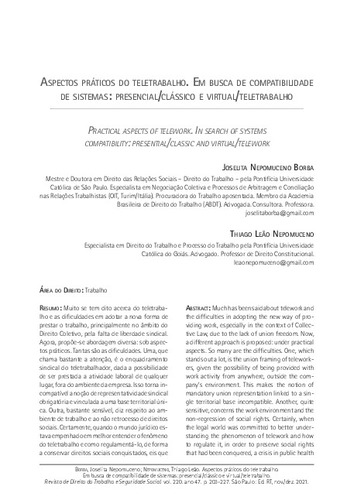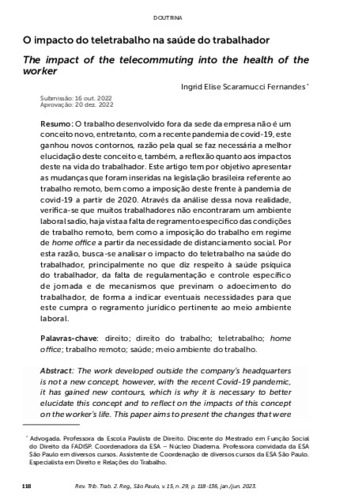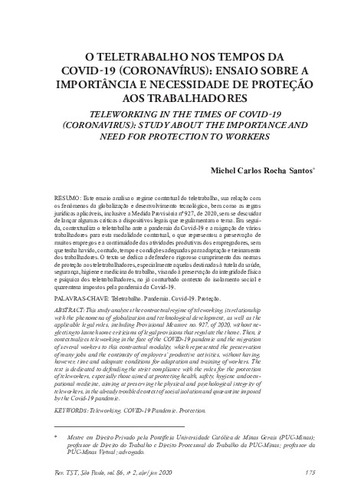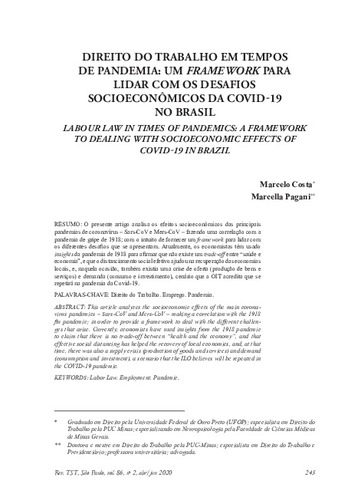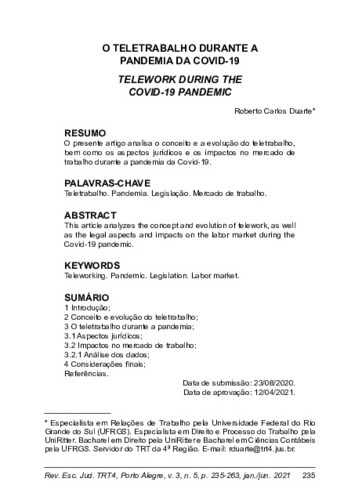Artigo de periódico
Teletrabalho e a pandemia no Brasil: uma análise durante e após a covid-19
| dc.contributor.author | Brito Filho, José Cláudio Monteiro de | |
| dc.contributor.author | Rothfuchs, João Vicente | |
| dc.contributor.author | Pereira, Sarah Gabay | |
| dc.date.accessioned | 2024-03-25T15:59:23Z | |
| dc.date.available | 2024-03-25T15:59:23Z | |
| dc.date.issued | 2023-02 | |
| dc.identifier.citation | BRITO FILHO, José Cláudio Monteiro de; ROTHFUCHS, João Vicente; PEREIRA, Sarah Gabay. Teletrabalho e a pandemia no Brasil: uma análise durante e após a covid-19 = Telework and the pandemic in Brazil: an analysis during and after covid-19. Revista de direito do trabalho e seguridade social, São Paulo, v. 49, n. 227, p. 169-195, jan./fev. 2023. | pt_BR |
| dc.identifier.uri | https://hdl.handle.net/20.500.12178/230917 | |
| dc.description.abstract | [por] Analisa um dos temas que marcaram a crise do coronavírus: o teletrabalho. A paralisação das atividades durante a pandemia confinou trabalhadores e forçou a adoção da referida modalidade. Assim, o objetivo do trabalho é verificar o impacto direto da pandemia na adoção do teletrabalho e averiguar suas perspectivas para um cenário posterior à pandemia. Para isso, utiliza o método indutivo, a fim de observar dados e fontes bibliográficas do tema, para concluir e responder ao problema em debate. Nesse sentido, contextualiza a pandemia do coronavírus, aborda sobre o instituto do teletrabalho e analisa dados divulgados durante a pandemia, para que seja respondido o seguinte questionamento: o teletrabalho é uma tendência após o período pandêmico? Resposta que será afirmativa. | pt_BR. |
| dc.description.abstract | [eng] In this study, we intend to analyze one of the themes that marked the coronavirus crisis: telework. The paralysis of activities during the pandemic confined workers and forced the adoption of this modality. Thus, the objective of this paper is to verify the direct impact of the pandemic on the adoption of telework, and to investigate its prospects for a scenario after the pandemic. For this, the inductive method will be used, in order to observe data and bibliographic sources on the subject, to conclude and answer the problem under discussion. In this sense, the work aims to contextualize the pandemic of the coronavirus, approaching the institute of telework and analyze data released during the pandemic, in order to answer the following question: is telework a trend after the pandemic period? The answer will be affirmative. | pt_BR. |
| dc.language.iso | pt_BR | pt_BR |
| dc.relation | Brasil. Medida provisória n. 927, de 22 de março de 2020 | pt_BR |
| dc.relation | Brasil. Medida provisória n. 1.108, de 25 de março de 2022 | pt_BR |
| dc.relation.ispartof | Revista de direito do trabalho e seguridade social: vol. 49, n. 227 (jan./fev. 2023) | pt_BR |
| dc.relation.uri | https://www.lexml.gov.br/urn/urn:lex:br:federal:medida.provisoria:2020-03-22;927 | pt_BR |
| dc.relation.uri | https://www.lexml.gov.br/urn/urn:lex:br:federal:medida.provisoria:2022-03-25;1108 | pt_BR |
| dc.subject | Teletrabalho, Brasil | pt_BR |
| dc.subject | Covid-19, Brasil | pt_BR |
| dc.subject | Reforma trabalhista, Brasil | pt_BR |
| dc.title | Teletrabalho e a pandemia no Brasil: uma análise durante e após a covid-19 | pt_BR |
| dc.title.alternative | Telework and the pandemic in Brazil: an analysis during and after covid-19 | pt_BR |
| dc.relation.references | Brasil. Consolidação das leis do trabalho (CLT) (1943), art. 75-B, § 1º, § 2º, § 4º, § 5º, § 6º, § 8º; art. 75-C, § 1º, § 2º, § 3º; art. 75-D; art. 75-E; art. 75-F | pt_BR |
| dc.type.genre | Artigo de periódico | pt_BR |
| dc.identifier.rvbisys | 1245393 | |
| dc.relation.ispartoflink | https://hdl.handle.net/20.500.12178/228977 | pt_BR |
| dc.relation.referenceslink | https://www.lexml.gov.br/urn/urn:lex:br:federal:decreto.lei:1943-05-01;5452 | pt_BR |
Coleção
-
Artigos9566


